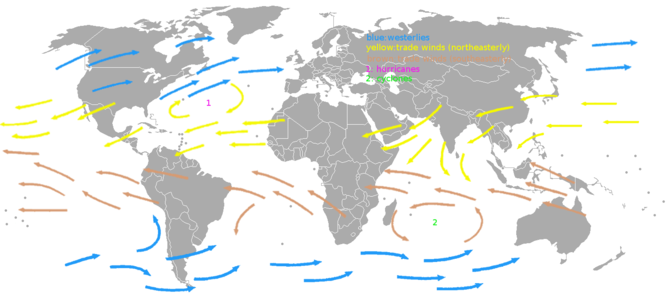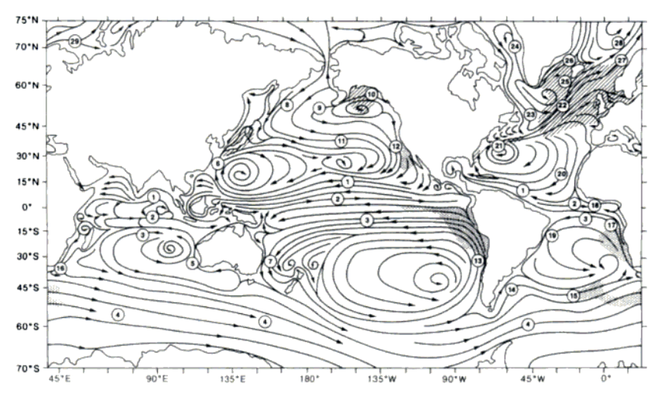Issues in Flight Analysis
Issues in Flight Analysis refers to the issues in using flight information as a scientific tool for determining the layout or dimensions of the Earth. It is often asked whether it is possible to use flights to determine information about the Flat Earth models under investigation (Ie. Bi-Polar Model).
There are many factors to consider other than geography, such as jet streams and trade winds. Non-stop flights are not necessarily non-stop. It is found that planes can and do travel at supersonic speeds (groundspeed) on a regular basis. Investigators have also found that listed flight times are purposely skewed by large amounts. Based on all of these complications, it is difficult to utilize the flights in any certain or meaningful way.
Listed Flight Times Skewed
Why Flights Take Longer
http://www.travelandleisure.com/travel-tips/airlines-airports/why-flights-take-longer (Archive)
“ Did you know that a flight from New York City to Houston, Texas is over an hour longer today than if you took the same flight in 1973? Now it takes about three hours and 50 minutes, but 43 years ago it would have taken 2 hours and 37 minutes. What gives?
~
Surprisingly, flight time is calculated from when the aircraft releases the parking brake (on push back) to when it sets the brake on arrival to the gate,” commercial pilot Chris Cooke told Travel + Leisure. “All that waiting in line during taxi and takeoff counts toward flight time.
Not surprisingly, saving money is another reason flights take longer today. “Airlines are able to save millions per year by flying slower," reveals a video from Business Insider. ”
Are You Being Told the Truth about Flight Times?
A study which says airlines are skewing flight times:
https://www.telegraph.co.uk/travel/travel-truths/Are-airlines-exaggerating-flight-times-so-theyre-never-late/ (Archive)
Are you being told the truth about flight times?
“ Passenger jets have never been more advanced. With Boeing’s 787 Dreamliner, introduced in 2011, leading the charge, and new models like the 737 MAX and the Airbus A320neo following in its wake, the aircraft on which we travel are safer, smoother, quieter and more fuel efficient than ever.
They also appear perfectly capable of flying faster than their predecessors. Just last month the low-cost carrier Norwegian issued a celebratory press release after one of its 787 Dreamliners whizzed from John F. Kennedy International Airport in New York to London Gatwick in five hours and 13 minutes, setting a new transatlantic record for a subsonic plane. That’s three minutes quicker than the previous best time set by British Airways in January 2015.
So why, record-breaking feats notwithstanding, are airlines claiming it takes longer and longer to fly from A to B?
That’s according to research by OAG, the aviation analyst, carried out for Telegraph Travel. It found that over the last couple of decades, despite new technology, scheduled flight times - ie. how long an airline estimates it will take to complete a journey - have actually increased by as much as 50 per cent.
Looking at Europe’s busiest international route, for example - Heathrow to Dublin - it found that in 1996 the vast majority of airlines published a scheduled flight time of between 60 and 74 minutes. Fast forward 22 years and almost all claim the journey takes between 75 and 89 minutes, while a handful bank on 90 minutes or more. ”
Jet Streams
1001 Questions
1001 Questions Answered About Hurricanes, Tornadoes, and Other Natural Air Disasters
“ Jet streams are ever-present, relatively narrow, streams of high-speed winds undulating around the Northern and Southern Hemispheres. ...Within these streams, winds travel at different rates of speed, from some 50 miles per hour at the outer edges of the stream, to some 250 miles per hour at the center. Speeds as high as 300 miles an hour have been reported. ”
Jetstreams Enable Routine Supersonic Flight (Groundspeed)
Riding a Wild Wind, Transatlantic Jets Fly Faster Than Ever Archive)
A 200-mph jet stream has sent several passenger jets to nearly 800 mph and helped break a (subsonic) speed record.
“ OK, about that "subsonic" bit. You might know that the speed of sound at an altitude of 30,000 to 40,000 feet is roughly 670 mph. But Norwegian’s planes didn't break the sound barrier. Those near-800-mph figures represent ground speed—how fast the aircraft is moving over land. Their air speed, which factors out the 200-mph wind boost, was closer to the 787's standard Mach 0.85. (The older Boeing 747 can cruise at Mach 0.86, but is less efficient than its younger stablemate.) When talking supersonic, and breaking sound barriers, it's all about the speed of the air passing over the wings, which in this case was more like 570 mph. ”
Anomalous Winds over the Southern Oceans
Australian Antarctic Division
http://www.antarctica.gov.au/magazine/2001-2005/issue-4-spring-2002/feature2/what-is-the-southern-ocean (Archive)
“ The Southern Ocean is notorious for having some of the strongest winds and largest waves on the planet. ”
BBC Earth
http://www.bbc.com/earth/story/20151009-where-is-the-windiest-place-on-earth (Archive)
“ There are huge belts of wind caused by the uneven way the Sun heats the Earth's surface. 30° north and south of the equator, the trade winds blow steadily. At 40° lie the prevailing westerlies, and the polar easterlies begin at around 60°.
Ask any round-the-world sailor and they will quickly tell you the stormiest seas, stirred by the strongest winds, are found in the Southern Ocean. These infamously rough latitudes are labelled the "roaring 40s", "furious 50s" and "screaming 60s". ”
Journal of Geophysical Research
https://agupubs.onlinelibrary.wiley.com/doi/full/10.1029/2003JD004179 (Archive)
“ The Southern Ocean is a vital element in the global climate. Its circumpolar current plays a crucial role in the global transport of mass, heat, momentum, and climate signals from one ocean basin to another. Moreover, the Southern Ocean hosts the strongest surface winds of any open ocean area, fostering strong heat, moisture, and momentum exchanges between the ocean and atmosphere. However, the Southern Ocean is tremendously undersurveyed by traditional observation methods because of the remoteness of the area and rough environment, causing the largest data gap of global oceans. ”
Easterly and Westerly Wind Directions
Prevailing Winds
Maps of the Trade-winds show that winds can travel in both Easterly and Westerly directions in the Northern and Southern Hemispheres:
Ocean Currents
The winds also cause the direction of the ocean gyes, which in turn show both Easterly and Westerly directions in the Northern and Southern Hemispheres.
Note: The seen clockwise and counter-clockwise prevailing wind and ocean currents runs contradictory to the Coriolis Effect. See Coriolis Effect (Weather)
Non-Stop Flights
Annoyed by a fuel stop on your direct flight?
https://www.cbc.ca/news/canada/north/airline-fuel-stops-divert-1.4495744 (Archive)
Annoyed by a fuel stop on your direct flight? Why airlines can't always plan ahead
“ Travel delays. We've all been there.
But there's something about fuel stops that particularly irritates travellers. Why didn't the airline plan ahead? How could it not know the aircraft would need more fuel?
In November Chad Hinchey was on a direct WestJet flight from Edmonton to Yellowknife when he says the pilot announced they were going to have to divert to Fort McMurray, Alta., because of bad weather.
Passengers were told that the plane didn't have enough fuel to attempt a landing in Yellowknife and fly to an alternate airport if it had to. ”
Flights Stop for Fuel
By SUSAN CAREY And ANDY PASZTOR
January 11, 2012
“ Dozens of Continental Airlines flights to the East Coast from Europe have been forced to make unexpected stops in Canada and elsewhere to take on fuel after running into unusually strong headwinds over the Atlantic Ocean
The stops, which have caused delays and inconvenience for thousands of passengers in recent weeks, are partly the result of a decision by United Continental Holdings Inc., the world's largest airline, to use smaller jets on a growing number of long, trans-Atlantic routes.
United's strategy works when the winds are calm, and it allows the airline to operate less expensive aircraft with fewer cabin-crew members to an array of European cities that wouldn't generate enough traffic to justify larger planes.
But by pushing its international Boeing Co. 757s to nearly the limit of their roughly 4,000-nautical-mile range, United is leaving little room for error when stiff winds increase the amount of fuel the planes' twin engines burn.
Last month, United said, its 169-seat 757s had to stop 43 times to refuel out of nearly 1,100 flights headed to the U.S. A year earlier, there were only 12 unscheduled stops on roughly the same volume of 757 flights.
Such stops are safer than eating into the minimum amount of reserve fuel pilots are required to keep on board, which guarantees that a plane can fly 45 minutes past its destination or alternate landing spot. ”
So-called nonstop flights now stop for fuel
Air travel: So-called nonstop flights now stop for fuel
“ In winter, to lower the odds of getting snowed in by an ice storm, a good idea is to choose warm weather for your connection, even if it seems a slightly longer trip. In summer, fogs and thunderstorms can also wreak havoc with airline schedules. Obviously, buying your tickets far in advance, there is no way to avoid these situations. But if you’re buying your ticket at the last minute, check a source like the Weather Channel before nailing down your final arrangements.
If the jet-setters of the 1960s had climbed aboard a plane designed 40 years before, they would have been getting into something with wooden wings. In some ways the world changed more rapidly and dramatically in your grandfather’s day than your own.
Accept the reality that most of the stress in travel by plane is out of your control. As you will quickly see, you have much less control of things in general than you might like to believe.
Be aware that so-called nonstop flights now stop for fuel. Flights to the East Coast from Europe are being forced to make dozens of totally unexpected stops in Canada and elsewhere to take on fuel after running into unusually strong head winds over the Atlantic Ocean. According to The Wall Street Journal and other sources, these stops, which have caused dramatic delays and inconvenience for thousands of passengers in recent weeks, are the results of a decision by United Continental, the world’s largest airline, to utilize a smaller jet on a growing number of long transatlantic routes.
The strategy works when the winds are calm. It allows the airline to operate less expensive aircraft. And with fewer cabin-crew members to an array of European cities that would not generate enough traffic to justify larger planes. But according to Susan Carey and Andy Pasztor, by pushing its 757s to nearly the limit of their roughly 4,000-nautical-mile range, United is leaving little room for error, especially when stiff winds increase the amount of fuel the planes’ twin engines burn. ”


